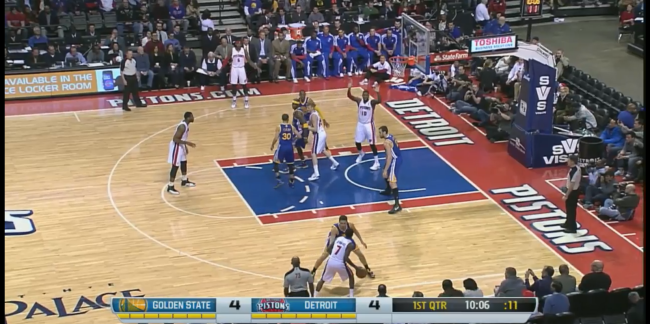In celebration of the Sloan Sport Conference that just took place in Boston, now seems like the perfect time to take a deeper look at some statistics that have been introduced by the new, SportVU cameras that all of the NBA arenas are now equipped with.
Firstly, what are these SportVU cameras? These cameras are able to recognize what players are on the court, and it measures every movement that is made. These cameras are able to measure things such as distance traveled, player speed, rebounding when opponents are in the area, how successful a player is when he catches the ball a certain distance from the rim, etc. Pretty much the only thing it can’t measure is how high a player jumps.
So, all of this data is measured, but what can a person do with all of the data? Fortunately, NBA.com has put together a nice database that allows for some simplicity in this matter. The public isn’t given full access to the data in the way that the actual teams are, but there is still some extremely useful information out there.
Now at 24-37, it’s no secret that Detroit hasn’t had the season that they thought they were going to have. So, why, with all of the talent that Detroit acquired, isn’t Detroit having an amount of success equal to that amount of talent?
A large majority of this lack of success can be tied to poor scheming. Earlier in the season, it was easier to blame this poor scheming on Detroit having a new team with a new coach, but as the season closes out, this excuse becomes less valid.
Now, what parts of Detroit’s game are these poor scheming decisions most prevalent? The first, biggest issue is that Detroit’s starting lineup has continued playing poorly together. They haven’t shown much progress, if any at all. Here is the Net Rating of the Pistons when Josh Smith, Greg Monroe, and Andre Drummond are on the court together for the months of November through February (Net Rating is based on how many points a team will outscore or be outscored in a normal, 100 possession game).
November: -6.5
December: -9.7
January: -6.6
February: -6
There is clearly a lack of success when Detroit’s, what most would argue, three best players are playing together. Before getting fired, coach Mo Cheeks swapped in Kyle Singler for Kentavious Caldwell-Pope (KCP) in the starting lineup. KCP’s minutes greatly diminished right around the beginning of February. So, Kyle Singler’s insertion into the lineup has yielded a solid .6 net rating increase with that starting lineup. That’s not exactly the increase that’s going to push Detroit into the playoffs.
So, why aren’t these talented players playing well together? The most obvious issue is spacing. Many teams like to stick a good shooter in each corner of the court. This opens up the floor on offense, and the corner 3 is the highest percentage three pointer a team can take. You can see this happening here by Golden State.
Those shooters in the corners are so important to guard that the entire lane is open for the pick and roll.
The Pistons are also using this strategy of putting a player in each corner, but the problem is that one of those two players is Josh Smith, who is shooting an extremely ugly 4-27 (14.8%) from the corners and 43-176 (24%) on three pointers not located in the corners. This pitiful three point stroke by Smith allows teams to sag off and clog the paint, as shown here (Smith is at the top of the screen).
It’s going to be very hard for Detroit to get a good shot with the way both teams are positioned in the above picture, and even if Detroit does manage to swing it to Smith in the corner, all it gets them is a sub 15% three point shot.
That clogging of the paint, when Detroit has such a poor shooting team on the court, takes away pick and roll efficiency, room for cutting, and room for Greg Monroe and Andre Drummond to post up. This poor offensive strategy has led to Detroit being a bottom five team in points per possession, according to MySynergySports.com.
All right, now let’s go back to the SportsVU data. The eye test says that Detroit, at times, lacks movement. Many offensive possessions seem to include an extraordinary amount of standing around. The advanced data backs this eye test up. One of NBA.com’s categories from these advanced cameras is distance moved. So, by knowing how many possessions have taken place, it was just the simple matter of breaking down movement per possession.
Detroit is the 5th least active team. Now, this isn’t automatically a bad thing. There are top tier teams and bottom tier teams scattered throughout these movement rankings. So, that leads to the questions: Why is this an important piece of data for this Pistons team, and why might this an issue?
A good place to start would be to look at the types of plays that Detroit is running. Fortunately, MySynergySports.com has all of this covered. Here is a chart showing the type of play run and how successful each play type is compared to the rest of the league.
As you can see, Detroit is great at getting offensive rebounds, and they are great at getting into transition, but when they are in a half-court set, they’re often getting Isolation (ISO) and Post-Up shots, and they’re failing miserably.
The good teams that are lacking movement have a star player or two who can succeed in ISO situations. They will often have good shooters who can spread the floor and create space for the isolation play. This is why Detroit’s earlier mentioned lack of spacing is an issue. Detroit is trying to shove a circle block through a square hole. The lineups that are being thrown out onto the court with the current scheme is just setting them up for failure.
Another troubling issue discovered through the advanced data is that Detroit is moving even less than their pace would suggest. There is a direct, statistical tie with how quickly a team plays and how much movement per possession they have. This isn’t any wild discovery. If a team usually shoots with 10 seconds left on the shot clock, they’re probably moving less per possession than a team that shoots with 5 seconds left on the shot clock, but while Detroit has the 10th fastest pace, they’re the 5th least moving team (In a perfect world, every team would have matching rankings). So, this means that Detroit, against teams who clearly sag down into the paint, aren’t including any extra movement to get that clogged paint opened up.
All right, let’s step back and look at more SportsVU data on NBA.com. There is some fantastic data that tells how many touches (times he gets the ball) a player has, how many passes a player has made and how much time the ball has been in a player’s hands. Through some simple math, it was easy to find each player’s touches to passes ratio, and it was also easy to find how long a player holds onto the ball every time he touches the ball. These two measurements are great at determining the league’s most selfish players – the players nobody wants to play pick-up ball with.
As a team, Detroit is passing the ball the 3rd fewest times per possession. So, it’s no surprise to see some of Detroit’s players pop up on “the selfish list,” but there’s one player who stood out the most: Rodney Stuckey. He holds onto the ball for over 6 seconds per touch. OVER SIX SECONDS! This allows teams far too much time to get set up or regroup. In comparison, Kyle Singler holds onto the ball for 1.75 seconds per touch. He either has the shot or he doesn’t. The ball keeps moving. Now, back to the most selfish player (we need a title for this award. Maybe The Stuckey?). There isn’t a single player in the NBA who is ahead of Stuckey in, both, touches per pass and seconds per touch. The only non-point guard ahead of Stuckey in seconds per touch is Dion Waiters, and the only players ahead of Stuckey in touches per pass are Klay Thompson, Nick Young (Swaggy P), Kevin Durant, Eric Gordon, Carmelo Anthony, Nikola Pekovic, Al Jefferson, and Demar DeRozan – 5 good shooters (although, Swaggy P takes a lot of bad shots), 2 big men, and a rich man’s Stuckey. Josh Smith was also relatively high on both lists, too, considering his position.
The advanced data backs up that Detroit lacks player movement and ball movement, but how can this issue be solved? The simplest (and most ego bruising) move would be to move Smith, Monroe or Drummond to the 6th man role, or, at least, stagger their minutes better. Remember all of those negative net rating numbers attached to the Smith, Monroe, Drummond combination? Well, when Brandon Jennings, KCP, Singler, Smith and Monroe share the court together, although, in limited minutes (80), they have a net rating of +24 – with a pace of over 100, they outscore their opponents by 25 points per 48 minutes,
There are a couple reasons why this suggested starting lineup is so successful. Firstly, all of those players are guarding the positions that they’re built to guard. They have a defensive rating of 94. This would be the best defensive rating in the NBA, just in front of the Indiana Pacers, who are at 94.9. Secondly, it would give the Pistons those two, key shooters that they are so desperately in need of to create spacing. The offensive rating of this lineup is 118. It is 8 points better than the number one Miami Heat.
Now, those numbers wouldn’t be sustainable, but it begs to ask this question: Why isn’t this combination of players given a real opportunity? But sadly, no amount of SportsVU data will ever be able to answer that question.



